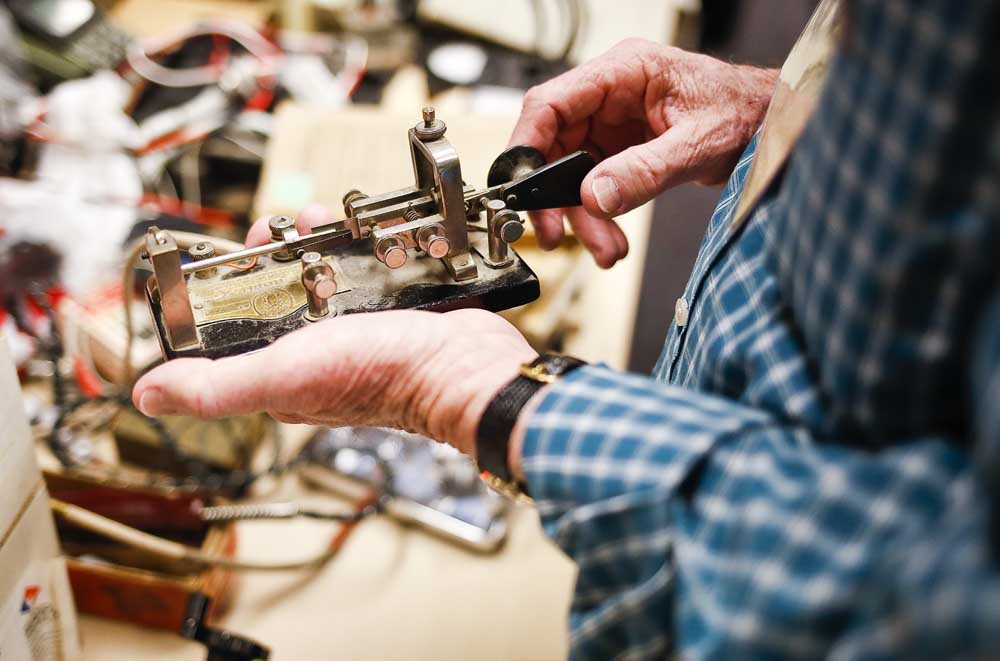In case of emergency, ham radio operators dial in
Published 3:56 am Tuesday, June 7, 2016

- John Foley from Hood River takes a look at a late 1930s Morse Code Keyer on sale at the SEA-PAC Ham Radio Convention flea market on Saturday, at the Seaside Civic and Convention Center.
SEASIDE — It was hot this weekend at the convention center, but sales were hotter on the floor of the SEA-PAC convention, the Northwest’s largest amateur ham radio show.
Before midday Saturday, Bill Eaton of Ham Radio Outlet in Tigard had sold out of the season’s most coveted item, the ICOM IC-7300. They go for $1,499, “but they’re gone.”
What makes this device so special? “It’s the new, great DSP (digital signal processing) filtering receiver, transmitter with SDR (software defined radio) built into it — it’s got a nice color touch screen,” Eaton said. “We had 16, they were gone in the first hour.”
Radio communications are expected to play an important role in the event of a disaster that brings down utilities.
From June 7-10, ham radio operators will participate in Cascadia Rising, the emergency preparedness exercise simulating the first four days following a Cascadia earthquake or tsunami.
“It doesn’t matter where you are,” SEA-PAC Public Information Officer Nicole Crosby said. “There are earthquakes in California, flooding in the Midwest and hurricanes in the East. Each one is its own problem area.”
Ham radio operators are in all generations — it’s a hobby spanning Morse code to the digital age.
Upstairs, novices and bargain-hunters alike prowled tables of used equipment.
“It’s what every amateur radio operator does,” Tim Coleman of the Clark County (Washington) Amateur Radio Club said. “We buy used equipment to get started in the hobby, then we upgrade equipment,” he said. “Then we sell the old stuff.”
Don Hawkins of Portland displayed R.L. Drake equipment from the 1970s, “the transition stage between vacuum tubes and semiconductors,” according to Hawkins.
Like Coleman and other flea market vendors, he said he looked forward to a trip to the convention floor “to buy new toys” from his own sales proceeds.
Downstairs, Portland’s Louis Bybee offered Morse code keys, power amplifiers for radio, soldering guns, tools, power supplies — what he called “a little bit of everything.”
Jack Tiley of Spokane, Washington, displayed antique measuring instruments donated by Gonzaga University to raise money for the local amateur radio club.
His prize was a potentiometer, a precision box for calibrating capacity devices.
“This was the way they did it before they had precision instruments,” Tiley said. “It’s very unusual. It’s what they used in the primary standards labs in the 1940s and ’50s. Today it’s a collector’s item or a museum piece.”
Ron Plummer of Los Angeles is celebrating his 70th year in ham radio.
“When we started in the hobby, it was all tubes,” Plummer said. “There weren’t any transistors. Almost everybody built their own equipment. Now you go to the store and buy what you need.”
Morse code still has its role in radio communications, Plummer said.
Also referred to as “CW,” or continuous wave, Morse code adds reach and is a “great way to talk to people all around the world,” especially when there is a language barrier.
Radio communications are expected to play an important role in the event of a disaster that brings down utilities.
At his SEA-PAC table, John Hays, director of marketing for NW Digital Radio, displayed a high-speed digital radio with expanded network reach. The UDRX-40 Universal Digital Radio sells for $395, and is supported on Windows, Android, Macintosh and Linux browsers. “There’s a resurgence in having an alternative way to send messages in a disaster,” Hays said.
In the Seattle area, hams are building a high-speed network to supplement the internet, which could be brought down in a disaster. “It’s bigger than Cascadia, but Cascadia’s certainly part of the motivation,” he said.
One vendor had nothing with a plug, battery or cable on her table.
Gretchen Otto, a distributor of Thrive Life, offered samples of “Freeze Dried Snackies,” ideal for a well-stocked home following a disaster, she said. “Once you open them, for most of the items, you have a year to eat the contents,” she said. “The beauty of it is, you can literally eat everything without water except maybe the sauces and cookies,” Otto said. “I’ve tried every meat, every vegetable, every fruit, without water. “Some were a little dry, but good.”
Whether getting into amateur radio for fun or for survival, newbies don’t need to spend the $1,500 necessary for state-of-the-art equipment. Used equipment can be found for under $100, and all radio operator tests are priced at $15, according to Crosby.
Entry level is called “technician,” followed by general license and amateur extra, which allows access to all available U.S. Amateur Radio operating privileges on all bands and all modes.
For more information, contact Clatsop County Auxiliary Communications or the Amateur Radio Emergency Service.
Local clubs include the Sunset Empire Amateur Radio Club, Seaside Tsunami Amateur Radio Society, Cannon Beach Amateur Radio Society and Oregon Coast Hams.
Links to these and other amateur radio groups can be found at clatsop-ares.org.
“From people who do it for fun, to contest teams, emergency communications, preparedness, weather-watchers — people use the ham radio,” Ham Radio Outlet’s Eaton said. “It’s a great means of communication.”





